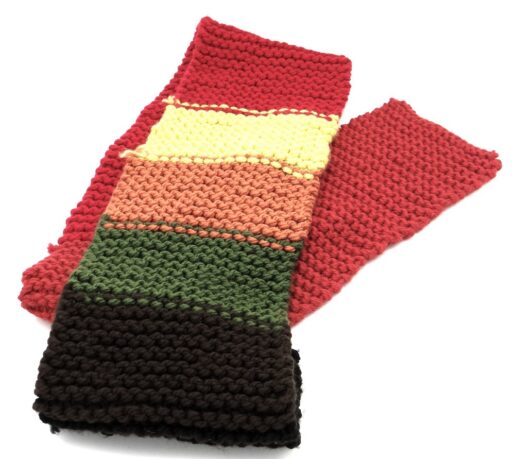
Scarf, African, Caribbean and Black Canadian HIV/AIDS Awareness Day, 2018.002.001
It’s February 7 and, if you didn’t know it, let this scarf draw your attention to the fact that it is African, Caribbean, and Black Canadian HIV/AIDS Awareness Day. This commemorative day was inspired by the American National Black HIV/AIDS Awareness Day, observed on February 7 every year since 1999. The colours of the scarf reflect the fight: red for HIV/AIDS. Yellow, orange, green, brown and black are Rastafarian colours and symbolise an allegiance and identification with Ethiopia. They are also the colours of the Jamaican flag: Black for the strength and creativity of the people; Gold for the natural wealth and beauty of sunlight; Green for hope and agricultural resources.
I was happy and proud to have acquired this scarf for Museum London’s collection at the 2018 launch of Black History Month here at the museum. It is one of the only objects in our collection with a clear story to tell about Black Londoners. In a city in which Black people have made a home for themselves since at least the 1830s, this is a sad state of affairs. Why are we in this position? Why does Museum London not have the objects that tell something about the lives of Black Londoners?
In part, it has to do with the museum’s history. Museum London’s historical collection grew from the London and Middlesex Historical Society, established in 1901 by White history-minded Londoners. They recognized the end of an era. The oldest Londoners with lived memory of London’s earliest days were dying. The founders of the new historical society wanted to preserve the memory of those pioneers. They appealed to others like themselves for stories of their ancestors in early London. Artifacts soon followed.
The collection grew to number some 300 objects. As the years passed, the collection grew. But the types of stories and the people represented stayed the same. As a result, many stories are missing. Black Londoners are not present. The waves of non-British and non-American newcomers to London are not present. Urban indigenous Londoners are not present. Londoners with a disability, Asian Londoners, and members of London’s LGBTQ+ community are only minimally represented.
Why is this the case? For the most part, the museum acquires artifacts through donations. Perhaps people didn’t realize that their objects and stories belong in London’s community museum and so did not seek to donate? Perhaps no one ever asked them to donate? Since I’ve been given this platform, I’m going to use it do two things. First, I’m going to say that your objects and your stories do belong in this museum. And I’m going to ask you to consider donating objects that illustrate your histories in this community.
We are a community museum. We collect the everyday. Objects don’t have to have great monetary value to be important here. Their richness lies in the stories they tell about people, their families, and this community. My call out to you is extra important right now. I’m working on a history exhibition of the city of London that will stay up for some time. I want it to tell the stories of all Londoners: Black, Indigenous, Asian, Latin American, South Asian, Middle Eastern, LGBTQ+, and more. I want it to tell the stories of Londoners whose families have been here for generations and Londoners who came last year. Will you add to London’s story?